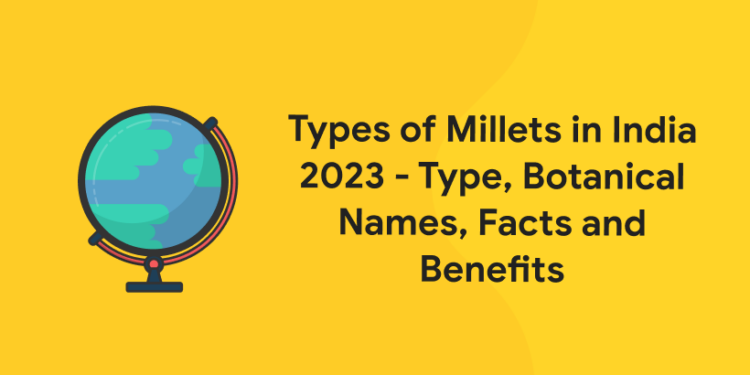Table of Contents
Generally, millets are considered to be a group of variable small-seeded grasses. Those grasses have widely grown the world as cereal crops or grains which is used as a source of food. They are a very important category of the food system and crops in the Asian strata like India and a report of 97% of crops are grown out in such developing nations. The temperature in such areas is a questionable statement for its massive production. It is indigenous to variant parts of the world and has become an inevitable part of the human food system. Explore the Types of Millets in India 2023 here!
What are Millets?
Millets are unrefined seeds that are grown and harvested in the Indian subcontinent for the last 7000 years. They are small-grained seeds that grow with the proper temperature and fertile ground. They include high nutritional value and are rich in proteins, vitamins, minerals, and fibers. Unlike other cereals, millets demand little water and ground fertility. They possess long appreciated the tag of “poor man’s food grain” due to its fine affordability.
Millets are of different types and forms. It can be grown and harvested in different areas of the world with the proper care and harvesting methodology. The agricultural sector has induced the need for the increased production of millets due to their affordability and nutrient quality in human beings. Let’s see some of the millets and types of millets in India in Hindi.
Types of Millets in India 2023
1: Who was the first woman President of India?
Naked grains
Naked grains are three common types that are without the hard, indigestible husk that some millets possess. Specifically, such millet categories include, Ragi, Jowar, and Bajra. These millets don’t demand processing after harvest. They can directly be utilized after being washed. These are the significant types that are extensively cultivated and entirely popular due to the availability and easy procedure as compared to the other millet and their long processes
Check out the latest mock test series on GK
Husked grains
The second kind of millets is the Kodo millet, Foxtail millets and Little millets. These varieties have an indigestible seed coat. The husk on them needs to be separated prior they are fit for consumption. Millets include a multitude of micronutrients such as iron. Also, they take time to digest, which doesn’t cause the blood sugar spike associated with easily digestible food. Adding millets into your diet can help you control diabetes. other types of Millets are listed below. Read further to explore the variant types of millets in India
- Pearl Millet is a huge source of proteins, it is recognized as Bajra in Hindi, Sajjalu in Telugu, Kambu in Tamil and Kambam in Malayalam
- Barnyard Millet is a great source of iron and fiber. It is recognized as Kuthiravali in Tamil, Oodhalu in Kannada, Odalu in Telugu, Kavadapullu in Malayalam and Sanwa in Hindi.
- Finger Millet is a staple that is a substitute for oats and cereals. It is known as Ragi in Kannada, Kelvaragu in Tamil, Koovarugu in Malayalam and Mundua in Hindi.
- Foxtail Millet is abundant in minerals and vitamins. It is known as Thinai in Tamil, Kirra in Telugu, Thinna in Malayalam, and Kangni in Hindi.
- Little Millet is also packed with iron and fibre, the local names are Chama in Malayalam, Same in Kannada, Samai in Tamil, Sama in Telugu and Kutki in Hindi.
- Proso Millet is recognized as Barri in Hindi, Panivaragu in Tamil & Malayalam, in Kannada it is called Baragu and Varigalu in Telugu
Millets are environment friendly and are extensively rain-fed crops and do not place pressure on our already declining water resources. These millets are high in nutrition and have been in the making of quality product every year. Such millets are easy to maintain and preserve which increases its demand.
Free UPSKILLING Courses!
Take your first step toward mastering in-demand skills, acing interviews, and securing top-tier jobs with Entri's free upskilling courses.
Start Learning!Types of Millets in India in Hindi
| SL | Millets (English) | Millets (Hindi) |
| 1 | Amaranth | Rajgira/ Ramdana |
| 2 | Barnyard | Sanwa/ Samvat ke Chawal |
| 3 | Buckwheat | Kuttu |
| 4 | Finger millet | Ragi/ Nachni |
| 5 | Foxtail millet | Kangni / Kakum |
| 6 | Kodu | Kodon |
| 7 | Little millet | Moraiyo/ Kutki/ Shavan/ Sama |
| 8 | Pearl millet | Bajra |
| 9 | Proso millet (broomcorn millet) | Chena |
| 10 | Sorghum | Jowar |
Gluten-Free Grains
| SL | Millets (English) | Millets (Hindi) |
| 1 | Rice | Chawal |
| 2 | Puffed Rice | Murmure |
| 3 | Beaten Rice | Poha |
| 4 | Corn, Maize | Makkai, Makki, Bhutta |
| 5 | Polenta | Makkai ka Daliya |
| 6 | Oats | Jaee |
| 7 | Quinoa | – |
| 8 | Tapioca Pearls, Sago | Sabudana |
| 9 | Water chestnut flour | Singhare ka aata |
Grains Consisting of Gluten
| SL | Millets (English) | Millets (Hindi) |
| 1 | All-purpose white flour | Maida |
| 2 | Barley | Jau / Jav |
| 3 | Broken wheat | Daliya (These days there is also gluten-free jowar daliya) |
| 4 | Bulgar | – |
| 5 | Couscous | – |
| 6 | Rye | – |
| 7 | Semolina | Sooji / Rava |
| 8 | Vermicelli | Seviyan, Sevaiyan |
| 9 | Wheat | Gehoon |
| 10 | Whole Wheat Flour | Gehoon aata |
Learn more GK facts and current affairs! Download Entri App
Botanical Names of the Millets
The different varieties of millets are available in India. All are branches of the family Poaceae (the grasses). Later these categories can be subdivided into other smaller segments of families as per their characteristic similarities and features.
The most commonly cultivated millets are
| Millets Species (Botanical Name) | Description |
| Eleusine coracana | Finger millet (also known as ragi in Hindi) |
| Eragrostis tef | Teff, often not considered to be a millet |
| Panicum miliaceum | Proso millet (common millet, broomcorn millet, hog millet, or white millet |
| Panicum sumatrense | Little millet (also known as Saamey in Kannada |
| Pennisetum glaucum | Pearl millet |
| Setaria italica | Foxtail millet, Italian millet, panic |
| Digitaria exilis | Also known as white fonio, fonio millet, and hungry rice or acha rice |
| Digitaria compacta | Raishan, farmed in the Khasi Hills of northeast India |
| Digitaria sanguinalis | Polish millet |
| Echinochloa esculenta | Japanese barnyard millet |
| Echinochloa frumentacea | Indian barnyard millet also recognized as Kodisama in Andhra Pradesh |
| Echinochloa stagnina | Burgu millet |
| Digitaria iburua | Black fonio |
| Paspalum scrobiculatum | Kodo millet (also known as Varagu in Tamil Nadu |
| Brachiaria deflexa | Guinea millet |
| Urochloa ramosa | Browntop millet |
| Sorghum bicolor | Sorghum, usually considered a separate cereal, but sometimes known as great millet |
| Coix lacryma-jobi | Job’s tears, also known as adlay millet |
| Echinochloa crus-galli | Common barnyard grass |
Millets Grown in India
Millets are cultivated in different parts of the Country. Some of the main areas of millet cultivation are given below.
- Haryana
- Gujarat
- Rajasthan
- Uttar Pradesh
- Madhya Pradesh
- Maharashtra
- Andhra Pradesh
- Karnataka
- Tamil Nadu
- Telangana
- Chhattisgarh
Free UPSKILLING Courses!
Take your first step toward mastering in-demand skills, acing interviews, and securing top-tier jobs with Entri's free upskilling courses.
Start Learning!Historical Facts about Millets in India
Little millet is considered to have been domesticated around 5000 years ago in India and Kodo millet around 3700 years before in India. Different millets have been introduced in some of the Yajurveda texts, identifying foxtail millet (priyaṅgu), Barnyard millet (aṇu) and black finger millet (śyāmāka), indicating that millet agriculture was occurring around 1200 BCE in India.
Nutritional Benefits of Millets (100g of each millet)
| Millets | Protein (g) | Fibre (g) | Minerals (g) | Iron (mg) | Calcium (mg) |
| Sorghum | 10 | 4 | 1.6 | 2.6 | 54 |
| Pearl millet | 10.6 | 1.3 | 2.3 | 16.9 | 38 |
| Finger millet | 7.3 | 3.6 | 2.7 | 3.9 | 344 |
| Foxtail millet | 12.3 | 8 | 3.3 | 2.8 | 31 |
| Proso millet | 12.5 | 2.2 | 1.9 | 0.8 | 14 |
| Kodo millet | 8.3 | 9 | 2.6 | 0.5 | 27 |
| Little millet | 7.7 | 7.6 | 1.5 | 9.3 | 17 |
| Barnyard millet | 11.2 | 10.1 | 4.4 | 15.2 | 11 |
| Teff | 13 | 8 | 0.85 | 7.6 | 180 |
| Fonio | 11 | 11.3 | 5.31 | 84.8 | 18 |
| Browntop millet | 11.5 | 12.5 | 4.2 | 0.65 | 0.01 |
Health Benefits of Millets
- Anti acidic
- Gluten-free
- Detoxify body
- Help lower cholesterol
- Prevents breast cancer and many other diseases
- Prevent type 2 diabetes
- Reduce blood pressure
- Protection against heart diseases
- Helps in treating respiratory conditions like asthma
- Optimize kidney, liver and immune system health
- Reduces risk of gastrointestinal conditions
- Helps in avoiding issues like constipation, excess gas, bloating
Get access to free mock tests and quizzes on General Awareness
Check for more relevant updated information in the official website of Indian Institute of Millet’s Research
Frequently Asked Questions
What are millets rich in?
Carbohydrates
What are the two types of millets?
Naked grain and Husked grains
Which best millet to lose weight?
Pearl Millet
Which millet is known as 'poor’s food'?
Bajra or Pearl Millet
Where is the origin of the Pearl Millet?
Africa












